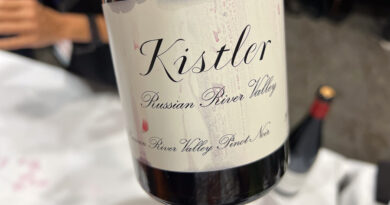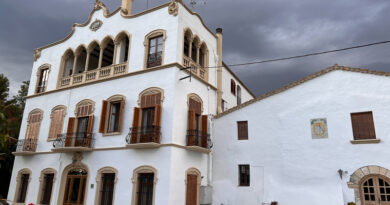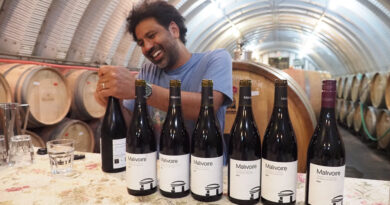Red Burgundy: Cote de Beaune, Cote Chalonnaise and the Maconnais
With Rajat Parr and Larry Stone
One of the highlights of TexSom is the seminar series, which covers a broad range of topics. This one, led by Raj Parr and Larry Stone, was a sell out, and looked at the red Burgundies from Côte de Beaune, Côte Chalonnaise and the Mâconnais. A lot of the attention for red Burgundy has focused on Côte des Nuits, but these three regions have a long history with Pinot Noir. Larry Stone pointed out that back in the middle ages the Dukes of Bourgogne appreciated the lively temperament of the wines on the Côte de Beaune and Hautes Côtes de Beaune. Back then, Pinot Noir dominated. Stone likes this area because it hasn’t seen some of the price inflation that other parts of Burgundy have. ‘I drink value,’ sauys Stone. ‘I drink a lot of wines that aren’t expensive.’

Domaine Michel Lafarge Bourgogne Passtoutgrain L’Exception 2016
Burgundy, France
Passtoutgrain is varietally defined, minimum 30% Pinot and 15% Gamay, whites
have to be less than 15% in the blend. Most are made in the Côte Chalonnaise
where Gamay is found. Gamay is a hard grape to ripen on limestone, which is why
it is blended. This wine is from an old parcel planted in 1928, co-planted,
fermented together. Half and half Pinot and Gamay, 100% destemmed. This is
bright, juicy and vital with lovely vivid, supple cherry and raspberry fruit
with some sappy notes. Really vivid with good acidity and a lovely vitality to
it. Very fresh. 92/100
Morey Blanc Aloxe Corton 1er Cru Clos de Chapitre 2015 Burgundy,
France
First recorded whites in this area were only planted in 1924. Before this
Corton was all red, and the reds today are much less appreciated than they were
historically. There are 101 hectares of Corton (red) and 49 hectares of
Corton-Charlemagne (white). On the top centre of the hill the soil is Oxfordian
white limestone that is better for white. Lower down the slope there is more
clay. Premier Cru Aloxe is mostly red. This vineyard is in the bottom part.
This is from purchased grapes, 100% destemmed, 30% new oak. Concentrated, lush
and ripe with bold, sweet concentrated black cherry and berry fruits, with some
spiciness. Very rich and ripe with a fleshy sheen to it. A really rich
expression of Pinot. 92/100
Domaine de Bellene Savigny Les Beaune Vieilles Vignes 2016 Burgundy, France‘Savigny is a very important appellation that sometimes get lost in a line-up,’ says Raj Parr. Bois Noël consists of south facing curves, with sandy marl covered with ferruginous oolites on the top and red brown crumbly limestone at the bottom. 65 year old vines from three plots, clay limestone soils, organic but not certified, 40% whole cluster aged in 600 litre barrels, a quarter new. This is fleshy and sappy with nice green notes complementing the bright cherry fruit with just a hint cedary oak, adding some spice and structure. Fine and expressive. 93/100
Joseph Drouhin Beaune 1er Cru Greves 2011 Burgundy, France
Beaune was the vinous centre of Burgundy. By 70 AD it was already covered in
vines. In 1395 Philip Le Hardi banned Gamay here. The walls were built in the
15th century. There are four distinctive areas in Beaune. This wine
is from 24 year old vines, facing south, dark clay/limestone and gravels,
destemmed, 20% new oak. Some development here with bricking at the rim, and
notes of malt and soy sauce on the nose. The palate is earthy and developed
with a savoury edge to the cherry and plum fruit. Looking a bit tired. 88/100
Philippe Pacalet Pommard 2017 Burgundy, France
Pommard is divided by the Dheune river. One the Beaune side there is stony
white marl at the top; redder and less stony in the middle. On the Volnay side
it is steeper, rockier and redder (e.g. Rugiens). This is whole cluster, 45
year old vines, no sulphites, aged in old casks. Really elegant and supple, and
light on its feet. Very fine red cherry fruit here with a lovely elegance: very
fine, silky and drinkable with lovely purity. Not typical Pommard. Very pretty
and delicate. 94/100
Domaine Nicolas Rossignol Volnay 2014 Burgundy, France
Marquis d’Angerville was the first domaine in Burgundy to exclusively bottle domaine wines. He was complaining about the fraud going on in the 1930s so they boycotted him. ‘It’s one of the most important villages,’ says Raj Parr. There are two extreme vineyards: Santenot is intense and tannic, but then at the north the wines are much more ethereal. This is from the bottom of the hill, and is a blend of parcels, with deep chalky soils and some clay with few stones. Under the 1er Crus Clos des Angles and Chevret. Fully destemmed, gentle extraction. Wild ferment. Supple, fine and elegant with some development. Has a bit of grip and some graininess, showing some tannin. Nice weight, drink now. 93/100

Hubert Lamy Chassagne Montrachet La Gougonne Vieilles Vignes 2016
Burgundy, France
Chassagne-Montrachet was historically red, and there was a lot of red there
until the 1980s. White is more desirable, so it’s planted even where Chardonnay
isn’t ideal. 1936: 80% red. 1992: 45% red. Today: 177 ha white and 132 ha of
red. Bathonian oolithic limestone bedrock, with top soils clay/marl with flaky
limestone gravels and chalk. Lower down there is more iron and clay, and this
suits reds better. This is from vines planted in 1950, lower altitude with clay
soil. 100% destemmed, aged in older barrels. [Combes are little valleys, and
this is in one of those.] This is fine-grained and elegant with lovely
precision to the sweet red cherry fruit, a smooth silky texture, and real
finesse. There’s good structure but it is cloaked in the elegant, sleek fruit.
Very fine. 95/100
Jean-Noël Gagnard Santenay 1er Cru Clos de Tavannes 2016 Burgundy,
France
Santenay is important, producing a lot of wine. It is unloved, generally.
Northern climats are gravel over Argovian (mainly) limestone. After a gap,
there are Bajocian marl soils. It’s 350 ha of Pinot Noir and 44 ha of
Chardonnay. SE facing slope, organic farming, 100% destemmed, one-quarter new
oak. Supple, fine and pure with lovely focused red cherry and berry fruits.
Very fine and fresh with some silkiness. Very pure and fresh showing great
detail and precision. Such elegance and finesse. 94/100
Michel Sarrazin et Fils Maranges 2016 Burgundy, France
Dezize, Cheilly and Sampigny combined in 1989 to create Maranges. Almost all
red (160 hectares of red, 5 ha of white). A gentle slope with stony brown
limestone at the top and more clay at the bottom. 25 year old vines, dense
chalk soils with some clay, 100% destemmed, 50% new oak (Francois Freres).
Supple, light, fine and elegant with pure red cherry fruit and a hint of
spiciness. Fresh and delicious with a lightness to it, but also some mid-palate
richness with a hint of cedary, spicy oak on the finish. 93/100
Domaine Vincent Dureuil-Janthial Rully 1er Cru Chapitre 2016 Burgundy,
France
Most of Rully is white, but there are 122 ha of red. This was planted in 1958,
low amounts of clay in the limestone soil. Destemmed, organic but not
certified. Vivid and bright with some tannins, as well as some spicy oak (one
third new). Focused and bright with some red cherry fruit. Lighter style with
vivid fruit, carrying a little too much oak at the moment. Good acid. 89/100
A & P de Villaine Bourgogne Côtes Chalonnaise La Digione 2017
Burgundy, France
Mercurey has 32 climats, 547 ha red and 100 ha white. Faiveley’s Clos du
Myglands is the most famous 1er Cru here. There are three different areas. This
is a site at the foot of the slope. Special site, organically farmed. This is
from Mercurey but isn’t labelled as such. Partially destemmed. Really perfumed
on the nose with sweet cherry and raspberry fruit. The palate is very fine and
silky, with lovely elegant, pure raspberry fruit. Elegant and supple with
amazing harmony. So pretty and expressive, and quite opulent. 95/100
Domaine Mouton Givry 1er Cru Les Grands Prétans 2016 Burgundy,
France
Givry was created in 1946 and includes 38 premier cru climats. 248 hectares of
reds and 55 ha of white. Higher altitude, gentle slope, clay/limestone. 100%
destemmed, 60% new oak. Vivid and bright with slightly tart red fruits and some
spicy oak. Vivid fresh fruit here with good acid and notes of cocoa and cedar
from the oak. Taut and quite brisk. 90/100




